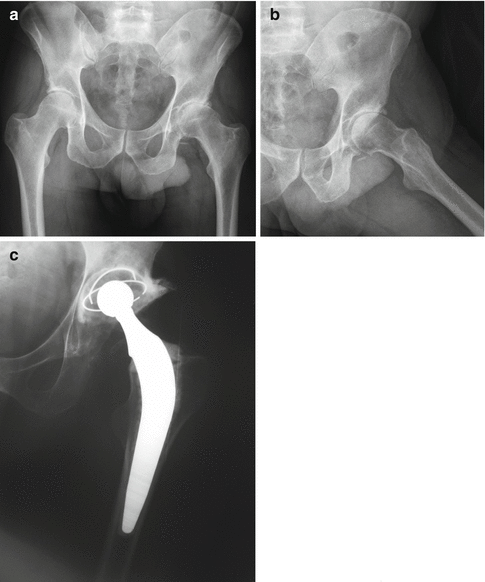Fig. 11.1
Total knee replacement (TKR) in a patient with hemophilia. Pharmacological thromboprophylaxis was not used: anteroposterior preoperative radiograph (a). Intraoperative view (b). Anteroposterior postoperative radiograph (c). Lateral postoperative view (d). Clinical view after surgery (e)

Fig. 11.2
Total hip replacement (THR) in a hemophilia patient performed without using pharmacological thromboprophylaxis. Anteroposterior preoperative radiograph (a). Lateral preoperative view (b). Postoperative radiograph (c)
For patients undergoing orthopedic surgery, the American College of Chest Physicians (ACCP) [2] has indicated that it is best not to use thromboprophylaxis for at least 10–14 days. This thromboprophylaxis can be performed with LMWH, with oral anticoagulants such as fondaparinux, dabigatran, apixaban, and rivaroxaban (THR or TKR but not in hip fractures) with low doses of unfractionated heparin, with adjusted doses of vitamin K antagonists, with aspirin, or with intermittent pneumatic compression device.
The ACCP’s preference is a combination of pharmacological thromboprophylaxis with LMWH for up to 35 days and an intermittent pneumatic compression device during hospitalization. In patients at high risk of bleeding, the ACCP recommends an intermittent pneumatic compression device or the absence of thromboprophylaxis. In patients undergoing arthroscopic surgery with no history of VTE, the ACCP advises against thromboprophylaxis. The aforementioned recommendations have been endorsed in other studies with a high level of evidence [3–7].
11.4 Thromboprophylaxis in Hemophilia Patients Undergoing Orthopedic Surgery
In 2000, Pruthi et al. [8] presented a patient with moderate hemophilia B (treated with factor IX concentrate) who suffered VTE in the operated leg after a THR for a hip fracture. It was later detected that the patient was a heterozygous carrier of the factor V Leiden mutation. His conclusion was that it could be useful to perform preoperative screening on those hemophilia patients who had previous history of VTE. That same year, Manucci [9] recommended that all thrombophilic patients should carry out short-term thromboprophylaxis with LMWH whenever they were exposed to significant risks (surgery, prolonged immobilization).
In 2004, Dargaud et al. [10] noted that, given the absence at that time of recommendations on thromboprophylaxis in people with hemophilia, this prophylaxis should not be routinely performed. However, they also noted that hemophilia does not fully protect against VTE. Therefore, they recommended performing thromboprophylaxis in specific cases in which there are clear risk factors.
In 2006, Butcher and Pasi presented a patient with hemophilia A, undergoing major pelvic surgery [11], who had several risk factors and ultimately died of a pulmonary embolism. Their conclusion was similar to that of Dargaud et al. [10].
In 2012, Uprichard et al. [12] analyzed a series of 13 TKRs in 11 patients with hemophilia B, who received mechanical thromboprophylaxis and 1 also received pharmacological thromboprophylaxis. No patients suffered VTE.
In 2012, Krekeler et al. [13] analyzed 85 patients (105 interventions, 90 with major orthopedic surgery, and 15 with minor surgery) without finding any cases of postoperative VTE despite not performing any kind of thromboprophylaxis. In 2012, Ozelo [14] reached the same conclusions as Butcher and Pasi [11] and Dargaud et al. [12]. In 2013, Berntorp [15] noted that in elderly hemophilia patients and in patients with von Willebrand disease, it will be necessary to assess the risk-benefit balance of thromboprophylaxis when they undergo major orthopedic surgery.
According to Ozelo for the majority of the patients, the use of gradated compression stockings and early mobilization can be sufficient to prevent venous thromboembolism [14]. The use of anticoagulant prophylaxis should be considered just for patients with relevant additional risk factor for thrombosis. However, for hemophilia patients with inhibitor, pharmacologic thromboprophylaxis is not recommended. For patients with von Willebrand disease receiving factor concentrates replacement therapy undergoing surgical procedures, the FVIII plasma levels should be monitored and thromboprophylaxis should be considered if any other thrombosis risk factor is present. It is important for the future to establish risk assessment tools that can help to determine the most effective and safe practice to prevent venous thrombosis in patients with hemophilia and other bleeding disorders who undergo surgical procedures.
Stay updated, free articles. Join our Telegram channel

Full access? Get Clinical Tree








